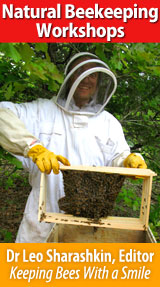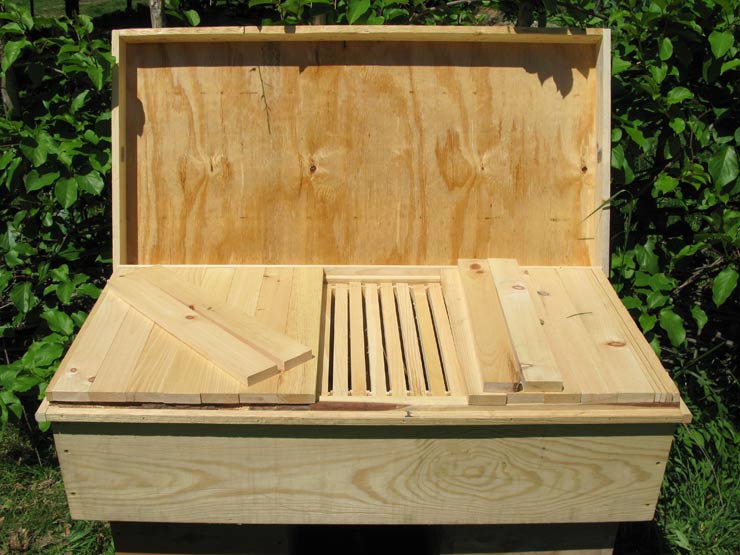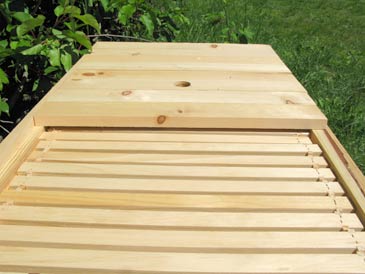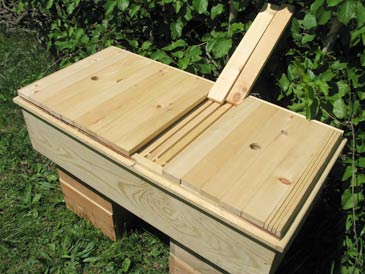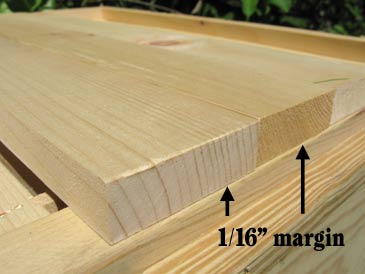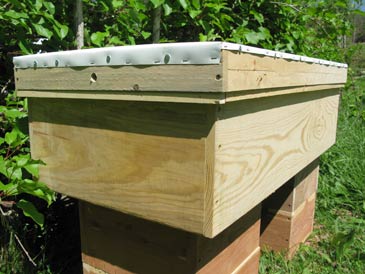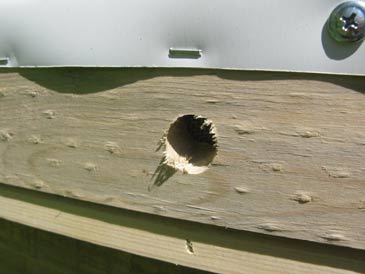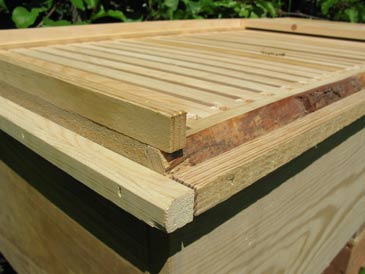Ventilated Hive Top & Cover Boards – Long Langstroth Hive – Free Plans
LAYENS HIVES AND FRAMES AVAILABLE FROM OUR STORE >>
Hives include all frames, fully assembled & ready to go
Layens horizontal hives have many advantages over Long Langstroth hives. Layens frames are better size for colony development and wintering. Top bars of Layens frames touch, minimizing heat loss during winter and bee disturbance during inspections. The space above Layens frames is well-ventilated, removing moisture and preventing overheating in the summer. In winter, this space can be filled with insulation. See Keeping Bees in Horizontal Hives for details.
Langstroth frames have a gap between the top bars. Opening the long hive, you expose the whole colony. If you cover the frames with burlap or other fabric, in warm climates it creates breeding space for small hive beetles. Covering frames with plastic also traps moisture in the bee nest.
In warm and hot climates a ventilated hive top (“Layens-style”) is preferable to the insulated one. So we can improve the Long Langstroth hive design by including a layer of cover boards and a ventilated top that leaves 2” of air space above the cover boards.
The idea is simple: cover the entire length of your horizontal Langstroth hive with narrow cover boards, 3/8” (bee space) above the frames. (See Figure 107 in de Layens’ book.)
The cover boards are ripped from “one-by” stock. I like making them about 2-5/8” wide. Do not make them too wide: they will warp. (This is because the space under the boards is more humid than the space above them.) Two of the boards have ventilation holes in the middle: 1-1/2” diameter, covered with metallic insect screen stapled into place from the bottom side. I place these vented cover boards towards each end of the box. Use insect screen to cover these openings (not 1/8” wire mesh, which will let small hive beetles and other vermin pass through it).
To prevent the cover boards from sliding out of place, a narrow rim is nailed to the body of the hive along three sides (front and both ends). Rim 1/2” wide by 3/4” deep, stapled to the hive box using 1-1/4” brads or nails. Long strip 47-13/16” long; two end strips 20-13/16”.
Leave at least 1/4” of empty space between the rim and the cover boards on left and right end — to allow for cover boards’ expansion. Never cram the cover boards — they should fit quite loosely. You can also put the rim along the back wall of the hive, but I don’t. Having the rim on three sides only (front and both ends) makes opening and closing the cover boards easier. When pushed against the front rim, the cover boards should stop 1/16” shy of the back wall edge — to allow for their movement and expansion and so they are never in the way of the closing lid. Cover boards would be 3/4” thick and 20-13/16” long.
The hive top has a 3-1/2” rim (made from “one-by-four”) and 3/4” diameter screened vents on both ends, centered. It is covered with aluminum flashing or, better still, white aluminum trim coil (to avoid glare). This top allows for some 2” above the cover boards, being propped up by the ledge running around the hive box.
To make the rim, cut two boards 3-1/2” x 3/4” x 21-5/8” and two boards 3-1/2” x 3/4” x 49-9/16”; connect on 1-5/8” screws (the short boards go between the long boards); cover with a piece of 1/4” plywood 49-9/16” x 23-1/8” stapling or nailing it into place with 1” staples or nails; cut flashing 24” x 51-11/16”, fold over the top and attach with 1/2” lath screws.
The ledge is made of 3/4” square bars running along the perimeter 1/2” down from the edge. Two sticks 21-3/8” long; two sticks 49-5/16”. The top can be attached on hinges. Exactly the same principles apply to building a ventilated gable (peaked) hive roof with a layer of cover boards underneath. Enjoy!
LAYENS HIVES & FRAMES AVAILABLE FROM OUR STORE >>
Hives include all frames, fully assembled & ready to go
If you haven’t signed up for our email list yet, please join it below so we can notify you when more free plans & information become available. (Only 2-3 emails per year, and you can unsubscribe at any time.) We are working to bring you the bees... and the smile!
— Dr. Leo Sharashkin, Editor of “Keeping Bees With a Smile”




